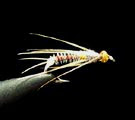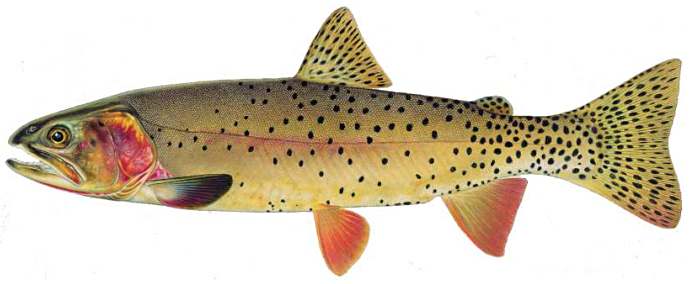FISHERS OF A GREATER GOD ?
Fishermen & Merchants ?
Samurai Fly Fishing ?
EBISU (YEBISU) to the rescue !
Samurai Fly Fishing ?
EBISU (YEBISU) to the rescue !
 .. With participation in fly fishing declining, and with the disappearance of fly shops across the nation, we thought it would behoove us
.. With participation in fly fishing declining, and with the disappearance of fly shops across the nation, we thought it would behoove us  to seek a remedy. It can be found with Ebisu, the god of fisherman and merchants, (no, not the pretty girl; the one on the wall with a fishing rod.)
to seek a remedy. It can be found with Ebisu, the god of fisherman and merchants, (no, not the pretty girl; the one on the wall with a fishing rod.).. It occurred to us, while perusing Fujioka's Home Page, that mastering small streams requires some outside intervention. Fujioka's newly added page about Traditional Japanese Flies reminded us that intervention was probably available from abroad. This thought triggered synapses as we recalled the mastery of the Gibbon River that has been shown by this Japanese fly fisher.
.. Ebisu is male, and one of Japan's Seven Lucky Gods.
 He is the god of fishermen and good fortune. He is smiling and bearded, and is most often depicted dressed as a Japanese peasant with a fishing rod in his right hand, and with a large red sea bream (Japanese = tai) dangling from the line or tucked under his left arm. In Japan, this fish (sea bream or red snapper) is a symbol of good fortune, (LINK.)
He is the god of fishermen and good fortune. He is smiling and bearded, and is most often depicted dressed as a Japanese peasant with a fishing rod in his right hand, and with a large red sea bream (Japanese = tai) dangling from the line or tucked under his left arm. In Japan, this fish (sea bream or red snapper) is a symbol of good fortune, (LINK.).. Japan is a nation very fond of fish; Ebisu is, not surprisingly, one of the most popular of the Seven Lucky Gods. Ebisu is also the only deity among the seven to originate in Japan.
.. Today he symbolizes not only safe sailing and plentiful fishing, but business prosperity for merchants in all trades. There may be hope for fly fishing and feather merchants here (LINK.)
.. Ebisu is often found in association with Daikoku. Daikoku originated in India, where he was known as Mahakata: a fierce, female warrior. She made her way to China where, because of her military prowess, she took on the task of guarding the food supplies in Buddhist temples.
.. Her image was often displayed in the
 kitchens of Chinese Buddhist temples (LINK.)
kitchens of Chinese Buddhist temples (LINK.).. When Buddhism came to Japan, it brought Mahakata along with it. Mahakata underwent a huge transformation in joining the Japanese pantheon as the distinctly male Daikoku.
.. These deities are very popular and employed by merchants, cooks, bicycle manufacturers, and beer brewers. There are districts of cities named after them. There are restaurants named for them. There are streets and villages named for them.
.. There is even a beer museum with this name 麦酒記念館. And the association of beer with successful fishing is well known and is not to be denied. (Go ahead and Google-up Yebisu Beer.)
.. Finally, need we say it,
 there may be a secret here to the mercantile success of Japanese business and the prosperity exhibited by their enterprise. Are fly shops disappearing in Japan? Most certainly not.
there may be a secret here to the mercantile success of Japanese business and the prosperity exhibited by their enterprise. Are fly shops disappearing in Japan? Most certainly not... It would seem that it's time for feather merchants, guides, devotees, and casual fishers to invoke the patronage of Ebisu. It appears that other sorts of invocations are failing. Now is the time for a revitalized approach to fly fishing; now is the time for Ebisu.
.. As an aside: the earliest flies of the Kaga District were used by Samurai in their exclusive privilege of fishing for trout. An interesting parallel to the earliest Victorian privileges in the British Isles, (of about the same time period.)
.. This impertinence is brought into focus when considering just how forceful a combination of Samurai fly fishing and congenial Shinto and Buddhist deities might be in the small streams of Yellowstone.
.. We're busy tying some


 flies illustrated by Fujioka from this period. They are very similar to several of the local flies that we're familiar with. They also have the advantage of being simple, straightforward patterns. We are in the hopes that they will bring us good fortune in our annual Spring grayling quest.
flies illustrated by Fujioka from this period. They are very similar to several of the local flies that we're familiar with. They also have the advantage of being simple, straightforward patterns. We are in the hopes that they will bring us good fortune in our annual Spring grayling quest... Well, it's time for a Montana Scramble, biscuits and gravy, fresh-squoze orange juice, and maybe a rasher of bacon to go with our freshly roasted coffee from Morning Glory.






.jpg)




